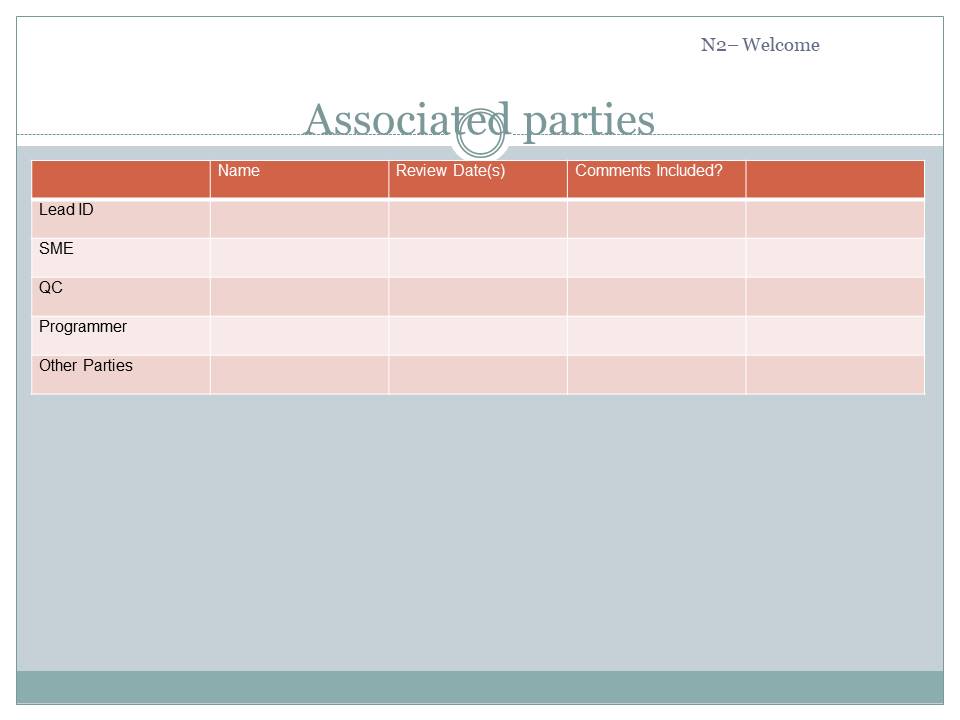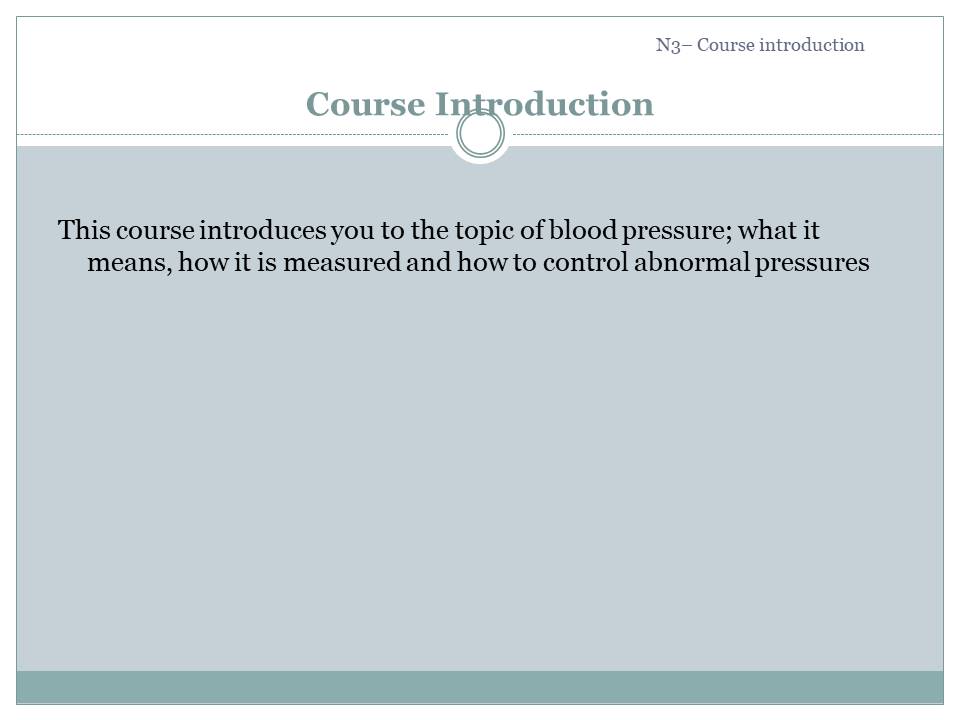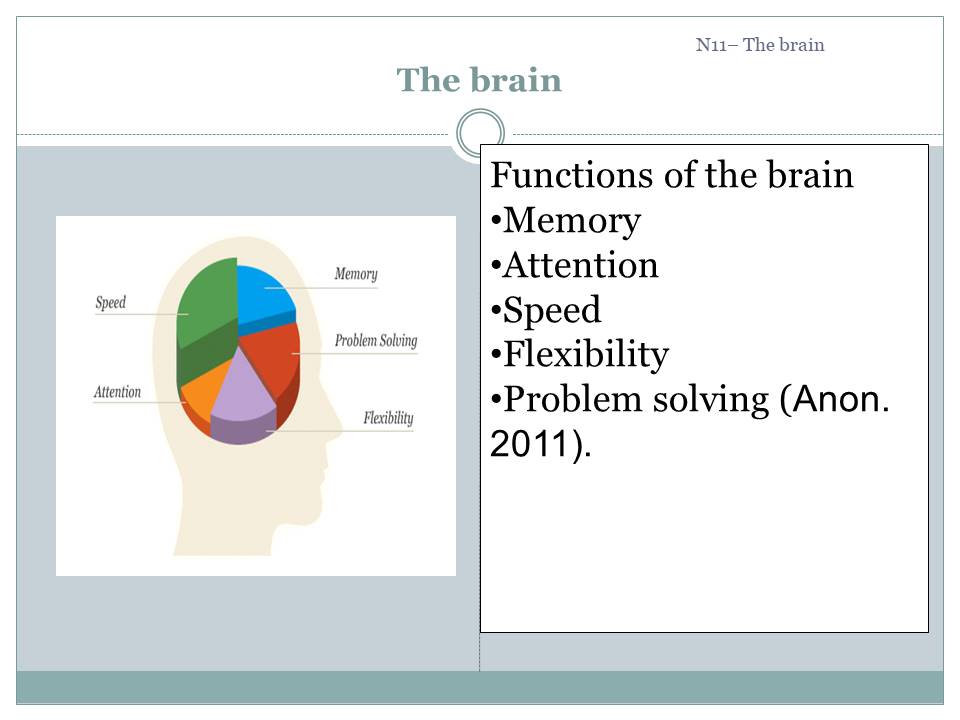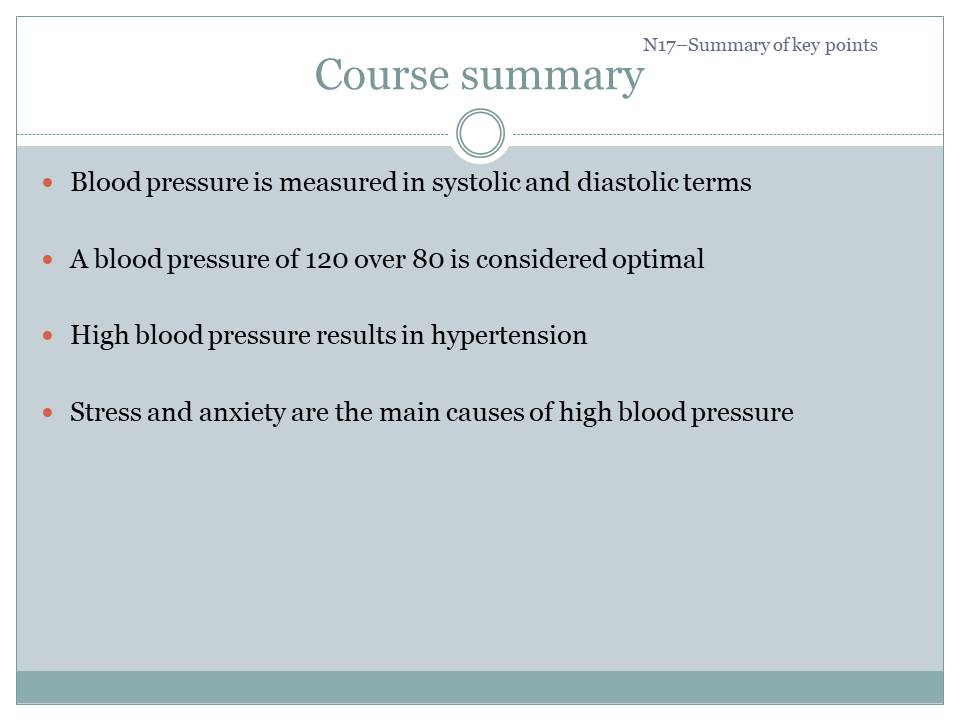Associated parties
The below chart shows the parties associated with this course. It gives the lead ID, the SME, QC, name of the programmer and other parties.

Course Introduction
This course introduces you to the topic of blood pressure; what it means, how it is measured and how to control abnormal pressures. This course is all about blood pressure; how to check it, and how to maintain a normal blood pressure. Different pictures and charts will be used in the entire course to illustrate key points.

Course content
- First unit:
- Blood pressure chart;
- Causes of high blood pressure.
- Second Unit:
- How to lower a high blood;
- Functions of the brain.
- Course summary;
- Scored Assessment.
- The “blood pressure chart” lesson discuss the different categories of blood pressure and what can be done in each category;
- The “causes of high blood pressure” lesson gives the main causes of high blood pressure;
- The “how to lower a high blood pressure” lesson looks at some of the measures that can be used to reverse high blood pressure;
- The “course summary” lesson provide a comprehensive summary of the course;
- Finally, you will complete the “Scored Assessment.”

Course Objectives
At the end of the end of the first unit, you will be able to:
- Define blood pressure;
- Identify the terms used to check blood pressure;
- Explain the different categories of blood pressure.
- Text: Blood pressure is one of the things most people are worried about. This is because when the blood pressure gets high, it can lead to serious heart and circulatory issues. People with abnormal blood pressures keep worrying and this worsens the situation.
At the end of this course, you will be able to:
- Text: define and be able to check blood pressure, explain blood pressure readings and give the different categories of blood pressure.
- Graphics: pictures of how to check patients’ blood pressure will be shown and a chart showing the different categories of blood pressure.
- Interaction/Activities: the graphics can be found on screen N7 and N8 respectively.

- At the end of the second unit, you will be able to;
- Give measures on how to control high blood pressure;
- Give the different functions of the brain and how training can be used to regulate blood pressure.
At the end of this course, you will be able to:
- Text: You should also be able to understand the different measures that an be used to control high blood pressure and the relationship between the functions of the brain and control of high blood pressure.
- Graphics: to illustrate this, different pictures will be used for the different functions.
- Interaction/Activities: these graphics are shown on screen N11 to N16.

Checking blood pressure
- Text: Blood pressure is checked in terms of millimeters of mercury (mm Hg). Blood pressure is measured in both systolic and diastolic terms (Neurologist 2006). Systolic pressure is the pressure exerted by the blood after a heart beat while diastolic blood pressure is measured between each heart beat. two numbers are written to represent these two terms, for instance, as 120/80 which is pronounced as ‘one twenty over eighty’. This is around the most favorable pressure, (even though 110/70 is sometimes estimated as a more preferable blood pressure). Blood pulse pressure is a term used to define the disparity between the two different blood pressure readings (that is diastolic and systolic). Normal blood pulse pressure is estimated at 40 mm Hg. Even though it can differ by a few points devoid of being seen as abnormal.
- Graphics: The above pictures are used to illustrate how blood pressure is checked.

Blood pressure chart
- Text: A normal blood pressure is considered to range between 120 over 80 and 140 over 90. If the blood pressure goes beyond this range, it is considered too high and can result in health issues. A person whose blood pressure is beyond 120 over 80 but below 140 over 90 is considered to be in the pre-hypertension stage (Neurologist, 2006). This is a dangerous stage and appropriate measures should be taken to bring the blood pressure down. Blood pressure above 140 over 90 is alarming and medical advice should be taken to control it.
- Graphics: the above chart gives a summary of the different type of blood pressure readings, their implication and measures that can be used to maintain a normal blood pressure.
- Interaction/Activities. For more information, user can go to the link provided below.
Causes of high blood pressure
The main causes of high blood pressure are:
- Anxiety;
- Stress (Rocio, 2009).
- Text: There are apparent connections between high blood pressure, obesity, resistance of insulin, metabolic syndrome, diabetes and cardiovascular disease. So there is enough reason to guard against it. Many people belive that high blood pressure is mainly caused by consumption of salt, but the answer is NO! The two main causes of high blood pressure are anxiety and stress. It is advisable for people who do not have a normal blood pressure not to worry so much because the blood pressure might even get higher.
- Graphics: The picture on screen N9 illustrates a very high blood pressure.
- Interaction/Activities. This links gives more information on the causes of high blood pressure.

How to lower high blood pressures
The common techniques that can be used to lower high blood pressure include:
- Meditation;
- Soothing music;
- Exercises;
- Healthy diet (Rocio, 2009);
- Text: Good meditation techniques, soothing music, deep breaths are some of the ways that can be used to keep a blood pressure as normal as possible. It is also advisable to avoid caffeinated beverages as this interferes with the blood pressure.

The brain
Functions of the brain:
- Memory;
- Attention;
- Speed;
- Flexibility;
- Problem solving (Anon. 2011);
- Text: In addition to the things discussed earlier (relaxing and reducing caffeinated beverages), brain exercises and can be used to lower blood pressure. Anxiety and stress are associated with the brain, thus if the different functions of the brain are used appropriately, high blood pressure can be prevented or lowered.
- Graphics: Figure shown on screen above explains the different functions of the brain.
- Interaction/Activities: Screen N12 to N16 expounds on this.

Memory
- Memory is one of the functions of the brain;
- It is the sharpest part of the brain;
- Memory is tied to general intelligence;
- Text: Memory is the sharpest part of the brain that is used to store information. A sharp memory helps one to remember certain things and improve performance. Good performance results in happiness and gets rid of anxieties and stress. More information is provided in the proceeding screens.
- Graphics: the sharp object is used to show.

Attention
Some people record high blood pressure due to luck of attention. If the level of attention is low, People end up making mistakes and this creates Stress and anxiety. Attention training can be used to improve this condition (Rocio, 2009).
- Text: Attention training improves the ability to perform well in exams and other activities that demand visual. Improved attention helps to filter out distraction thereby increasing productivity which reduces anxiety.
- Graphics: figure on N12 illustrates this function.

Speed
- Thinking fast and clearly;
- Quick thinking solves problems instantly;
- Text: Exercising the metal processing speed helps in thinking more quickly and clearly and therefore get rid of anxieties and stress. It also helps in increasing alertness and awareness. This can be achieved through brain speed training.

Flexibility
The brain is like a spiral that can be stretched to different shapes and sizes. It helps in:
- Strategic thinking;
- Controlling impulses;
- Avoiding mistakes (Anon. 2011);
- Text: Flexible thinking helps to articulate thoughts better and provide a person with the discipline to refuse to give in to temptation. When one is able to think flexibly, precision and cognitive control are improved. Flexible thinking skills can be improved by taking some flexible exercises. These skills include strategic planning, controlling impulses, and avoiding mistakes.
- Graphics: figure above shows that the brain is not static but flexible.

Problem solving
- This helps in making accurate decisions;
- Avoiding mistakes, thus avoiding anxieties (Anon. 2011);
- Text: Problem solving skills can help in making accurate decisions. People need to train their problem solving skills that will help them in making mental estimates and thus achieve more efficient thinking. The brain is the key to every thing and if used properly, many illness can be prevented.
- Interaction/Activities: user clicks here and goes to this link for more information.

Course summary
- Blood pressure is measured in systolic and diastolic terms;
- A blood pressure of 120 over 80 is considered optimal;
- High blood pressure results in hypertension;
- Stress and anxiety are the main causes of high blood pressure;
- Healthy eating, exercises, soothing music, among others can be used to manage high blood pressure;
- Proper use of the brain is the key to preventing high blood pressure.
Let’s review some of the key points in this course. Blood pressure is measured using two terms systolic and diastolic (screen N7 and N8).
A blood pressure of 120 over 80 is considered to be normal and beyond this reading is dangerous. High blood pressure results in a condition called hypertension which can be managed by seeking medical advice in addition to healthy eating and exercises. The main causes of high blood pressures are stress and anxiety (Rocio, 2009).
From this course it is clear that control of high blood pressure is the sole responsibility of an individual. This can be achieved by eating a healthy diet, exercising regularly and taking enough time to relax.
If the brain is taken care of properly, then the problems of high blood pressure can be reduced.


Scored assessment
- What is blood pulse pressure?
- Blood pressure is measured in?
- Consumption of salt is the main cause of high blood pressure, yes or No. Explain your answer
- What is the normal blood pressure reading?
- What are the measures that can be used to control high blood pressure?
After completing this course, you should be able to answer the above simple questions. This questions are designed to test whether you have understood the course. The questions are graded with a rubric that is based on the objectives of the study.

Congratulations on completing this course
You have come to the end of this course, congratulations for your time and effort.
Congratulations! You have completed this course.

Reference list
Anon. (2011). Lumosity reclaim your brain. Web.
Neurologist., L. (2006). Chart of normal blood pressure is a ready recknor. Web.
Rocio, J. (2009). How to control high blood pressure. Web.